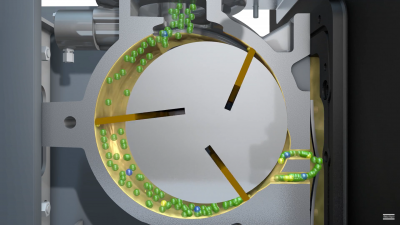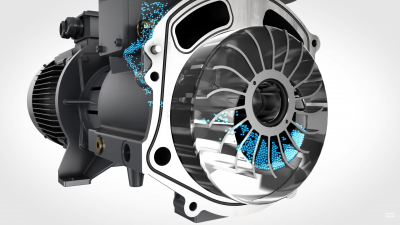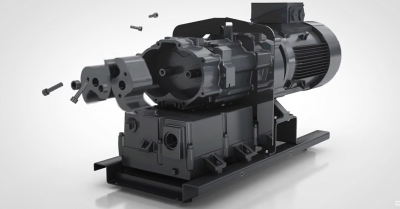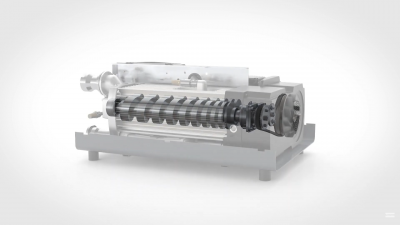A vacuum pump is a device that removes gas molecules or air particles from a sealed volume in order to achieve difference in pressure creating a partial vacuum. Vacuum pumps are designed in a variety of technologies based on the pressure requirements and the application it services. When setting up a vacuum pump system, sizing to the correct parameters is crucial to achieve optimum efficiency.
How Does a Vacuum Pump Work?
Vacuum is a space devoid of matter where the gaseous pressure inside this volume is below atmospheric pressure. A vacuum pump’s main function is to change the pressure in a contained space to create a full or partial vacuum either mechanically or chemically. Pressure will always try to equalize across connected regions as gas molecules flow from high to low to fill the entire area of that volume. Therefore, if a new low-pressure space is introduced, gas will naturally flow from high-pressure area to the new area of low-pressure until they are of equal pressure. Notice this vacuum process is created not by “sucking” gases but pushing molecules. Vacuum pumps essentially move gas molecules from one region to the next to create a vacuum by changing high and low-pressure states.
Vacuum Pump Basics
As molecules are removed from the vacuum space, it becomes exponentially harder to remove additional ones, thus increasing the vacuum power required. The pressure ranges are placed into several groups:
- Rough/Low Vacuum: 1000 to 1 mbar / 760 to 0.75 Torr
- Fine/ Medium Vacuum: 1 to 10-3 mbar / 0.75 to 7.5-3 Torr
- High Vacuum: 10-3 to 10-7 mbar / 7.5-3 to 7.5-7 Torr
- Ultra-High Vacuum: 10-7 to 10-11 mbar / 7.5-7 to 7.5-11 Torr
- Extreme High Vacuum: < 10-11 mbar / < 7.5-11 Torr
Vacuum pumps are classified by the pressure range they can achieve to help distinguish their capabilities. These classifications are:
- Primary (Backing) Pumps which handle rough and low vacuum pressure ranges.
- Booster Pumps handle low and medium pressure ranges.
- Secondary (High Vacuum) Pumps handle high, very high and ultra-high vacuum pressure ranges.
Depending on the pressure requirements and operating application, vacuum pump technologies are considered either wet or dry. Wet pumps use oil or water for lubrication and sealing, while dry pumps have no fluid in the space between the rotating mechanisms or static parts that are used to isolate and compressing gas molecules. Without lubrication, dry pumps have very tight tolerances to operate effectively without wear. Let us look at some of the methods used in a vacuum pump.
Capture Pumps
Capture pumps, also referred to as entrapment pumps, have no moving parts and are used for applications that require extremely high vacuum pressures. Without moving parts, capture pumps can create a vacuum environment using two different methods.
Cryopump (Dry, Secondary): Pressure 7.5 x 10-10 Torr, Pumping Speed 1200 – 4200 I/s
One of the methods used by capture pumps, is by trapping gas molecules through cryogenics to trap gas molecules. Cryopumps use cryogenic technology to freeze or trap the gas to a very cold surface. By using extremely cold temperatures, they effectively draw molecules inward to create a vacuum.
Sputter Ion Pumps (Dry, Secondary): Pressure 7.5 x 10-12 Torr, Pumping Speed 1,000 I/s
Sputter Ion pumps use highly magnetic fields and ionization of gas molecules to make them electrically conductive as a method of entrapment. The magnetic field creates a cloud of electropositive ions that are deposited onto a titanium cathode. In this process, the chemically active materials combine with gas molecules to draw them in and create a vacuum.
Transfer Pumps
Transfer pumps can operate using two types of methods; Kinetic energy or Positive Displacement. Unlike like Capture Pumps, Transfer pumps are pushing the gas molecules out of the space through the system. What they have in common is they all use a method of mechanically pushing gas and air through the system at different system intervals. Its common that multiple transfer pumps are used together in parallel to provide higher vacuum and flow rate. It is also common to utilize multiple transfer pumps in a system to allow for redundancy in the event of a pump failure.
Kinetic Pumps
Kinetic Pumps use the principle of momentum through impellers (blades) or introducing vapor to push gas towards the outlet.
Turbomolecular Pump (Dry, Secondary): Pressure 7.5 x 10-11 Torr, Pumping Speed 10 – 50,000 I/s.
All Kinetic pumps are secondary pumps as they are used for high pressure applications. One dry method is the Turbomolecular pump, which use high speed rotating blades inside the chamber that propel the gas molecules. Transferring momentum from the rotating blades to the gas molecules increasing their rate of moving towards the outlet. These pumps provide low pressures and have low transfer rates.
Vapor Diffusion Pump (Wet, Secondary): Pressure 7.5 x 10-11 Torr, Pumping Speed 10 – 50,000 I/s.
Vapor Diffusion Pump use high velocity heated oil steam that uses kinetic energy to drag gas molecules from the inlet to the outlet. There are no moving parts and there is a reduced pressure at the inlet.
Positive Displacement Pumps
The other form of Transfer type is Positive Displacement. The basic principle of a Positive Displacement pump is by expanding the original volume into the chamber they move small, isolated volumes of gas at different stages, compressing to a smaller volume and at a higher pressure expelled to the outside. These pumps operate at lower pressure ranges and are categorized under primary or booster pumps and incorporate wet or dry technologies. Here are the various types of positive displacement primary vacuum pumps:
Oil Sealed Rotary Vane Pump (Wet, Primary): Pressure 1 x 10-3 mbar, Pumping Speed 0.7 – 275 m3/h (0.4 – 162 ft3/min)
Oil Sealed Rotary Vane pumps compress gases with an eccentrically mounted rotor that turns a set of vanes. Due to centrifugal force, these vanes slide out and form chambers between themselves and the housing. The pumped medium is trapped inside these chambers. During further rotation, their volume is constantly reduced. Thereby, the pumped medium is compressed and transported to the outlet. Rotary vane vacuum pumps are available in single- and two-stage versions.

Liquid Ring Pump (Wet, Primary): Pressure of 30 mbar, Pumping Speed 25 – 30,000 m3/h (15 – 17,700 ft3/min)
Liquid ring pumps have an off-center impeller with vanes bent towards rotation that form a moving cylindrical ring of liquid around the casing from centrifugal acceleration. The vanes create crescent shaped spaces of different sizes as they rotate and are sealed by the liquid ring. Near the suction or inlet, the volume becomes larger causing the pressure in the each one to drop and draw in gas. As it rotates, the volumes between each vane decreases because of the eccentrical positioned impeller and liquid ring formation. This compresses the gas as it discharges, creating a continuous flow.

Diaphragm Pump (Dry, Primary): Pressure of 5 x 10-8 mbar, Pumping Speed 0.6 – 10 m3/h (0.35 – 5.9 ft3/min)
Diaphragm pumps are dry method positive displacement vacuum pumps. A diaphragm sits on a rod connected via crankshaft that moves the diaphragm vertically as it rotates. When the diaphragm is in the low position, volume in the chamber increases, lowering the pressure and pulling air molecules in. As the diaphragm moves up, the volume is decreased, and gas molecules are compressed while flowing to the outlet. Both the inlet and outlet valves are spring loaded to react to the pressure changes.
Scroll Pump (Dry, Primary): Pressure of 1 x 10-2 mbar, Pumping Speed 5.0 – 46 m3/h (3.0 – 27 ft3/min)
Scroll pumps use two non-rotating scrolls in a spiral design, where the inner one orbits and traps a gas in the outer volume space. As it orbits the volume of gas gets decreasingly smaller and smaller, compressing it until it reaches minimum volume and maximum pressure allowed and is expelled at the outlet located at the center of spiral.
Roots Style Pumps (Dry, Booster): Pressure <10-3 Torr, Pumping Speed 100,000 m3/h (58,860ft3/min)
Root pumps push gas in one direction through two lobes that mesh without touching as the counter rotate. This counter rotating creates maximum flow rate as the volume increases at the inlet at the simultaneously decreasing at the outlet compressing the pressure. These pumps are designed for applications where removal of large volumes of gas is required.
Claw Pumps (Dry, Booster): Pressure 1 x 10-3 mbar, Pumping Speed 100 – 800 m3/h (59 – 472 ft3/min)
Claw pumps have two rotary claws that counter rotate. They are extremely efficient, reliable, and low maintenance, and often used in harsh industrial environments. The Claws come within 2/1000’’ of each other, but never actually touch. This minimal clearance between the Claws and the chamber housing optimizes the internal seal, eliminating wear and the need for lubricants or oils.

Screw Pumps (Dry, Booster): Pressure 1 x 10-2 Torr, Pumping Speed 750 m3/h (440 ft3/min)
Screw pumps utilize two rotating screws horizontally placed along the inside of a chamber, one left-handed and one right-handed, that also mesh without contact. Gas molecules introduced at one end are trapped between the two screws, and as they turn in opposite directions gas is pushed into space with decreasing volume, compressing it as it reaches outlet and creating a reduced pressure by the inlet.

Conclusion
As you can see, determining what vacuum pump you may need for your gas removal process can vary on so many factors. These include pumping pressure and speed ranges, flow rate, gas type application, volume size, life expectancy and the location of your system. This can be a daunting task that can be time consuming and costly if not chosen right. Anderson Process can make this selection process simple with expert knowledge, a vast array of pumps and equipment inventory and full engineering and fabrication facilities if your system require a custom manufactured solution.
Anderson Process is an authorized provider of a unique range of products that can meet the demand for diverse applications in every industry. These pump types are Rotary Vane, Rotary Lobe, Liquid Ring, Scroll, Dry Screw and Claw pumps with full selection of pressure ranges and pumping speeds to handle the flow rates your vacuum application requires.
